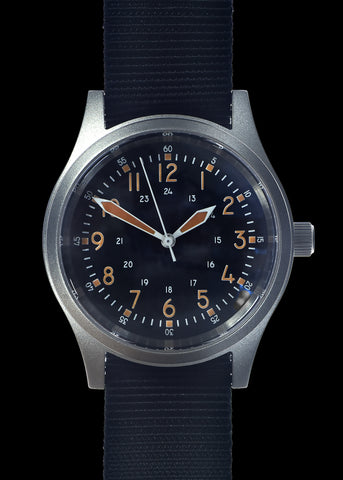WWII 1940 Pattern American Army Ordnance / ORD Watch (Hand Wound Mechanical Version)
€239,00
Product Details
SKU: ORD1/HW
In WWII Ordnance watches were made for the US military by Waltham, Hamilton, Bulova and Elgin. The original watches were made of nickel-plated brass because wartime conditions precluded the use of stainless steel as a consequence the original watches were not very durable hence finding one in good and sound condition is very challenging. The original watches were very small and measured 33/34mm but we increased the size slightly to 36.5 mm excluding the crown and 39 mm including the crown.
The US Army Ordnance Department watches were intended for use by non-aviation personnel; the A-11 which is similar but with a black dial was the USAAF equivalent.
The interesting thing about the design generally is that the British War Office procured a very similar timepiece in 1938 which was two years before the ORD watches hence the reason the watches both look pretty much identical.
Before WWII and particularly during WWI soldiers adapted all sorts civilian pocket watches and trench watches to their needs and this situation also existed with American troops. It was only following World War One that the British War Office decided to procure watches designed specifically for military use and the US Army Ordnance Department went down exactly the same path.
During WWII U.S Army personnel were issued with watches by the "ORD DEPT" In 1940, the Ordnance Department published the specific requirements and specifications for military watches hence ORD and ATP watches were very similar in basic specification and design which met the key objective which was to standardise the timepieces in use.
The original watches were handwound, this particular watch retains the hand winding mechanical movement, there is also a self winding automatic version for buyers who prefer not to wind the watch by hand each day.
For comparison the last two images were sent to us by a watch enthusiast and show original WWII watches made by Elgin which are ORD watches the third image is a Grana which is a British military ATP watch, as you can see they followed a very similar design with minimal differences.
Specification:
- Case Diameter: 36.5 mm exc crown, 39 mm incl crown
- Lug to Lug 43 mm
- Thickness 13.5 mm
- Lug Type: Spring Bars
- Dial Colour: Off White
- Case Material: 316L stainless steel
- Caseback: 316L stainless steel
- Crown: 316L stainless steel
- Water Resistance: 5 ATM (50 m)
- Movement: 21 Jewel Mechanical Handwinding
- Subsidiary second hand
- Glass: Plexiglass / Perspex
- Luminous Material: Luminova
- Serial number on caseback
- Strap: 18 mm Canvas
- 24 Months Guarantee































Connect